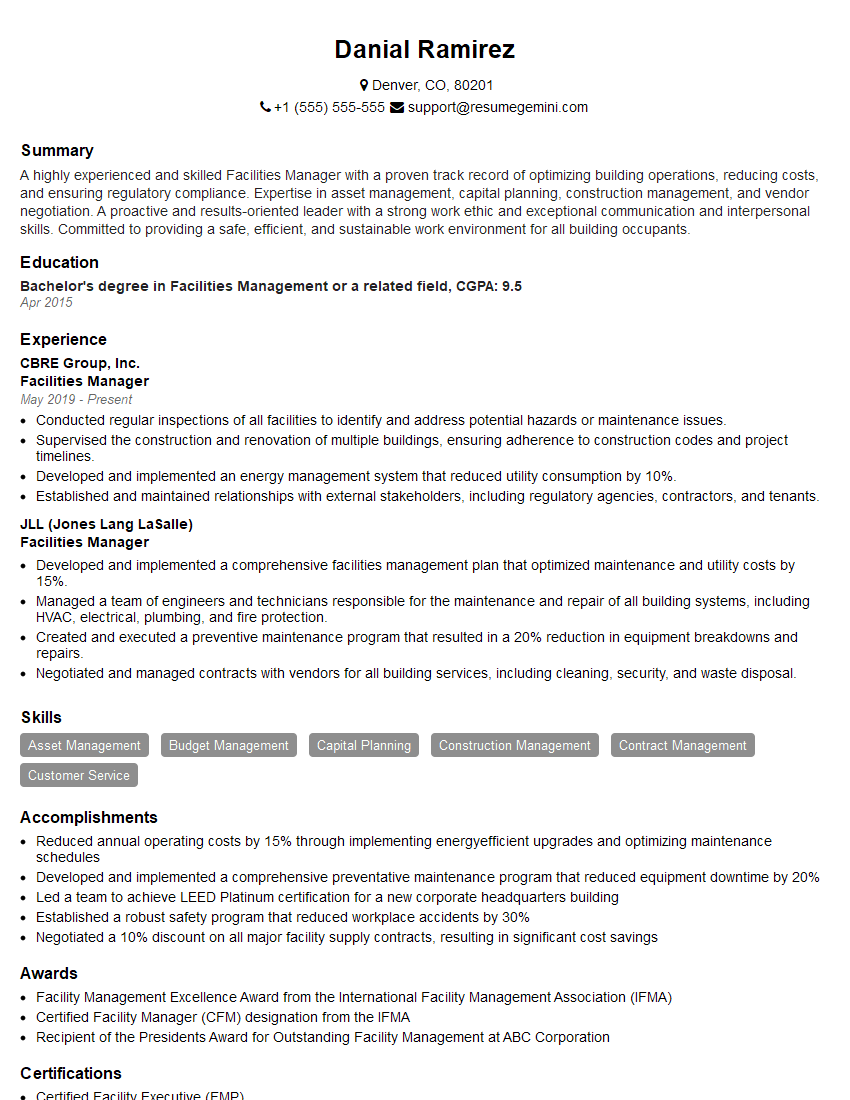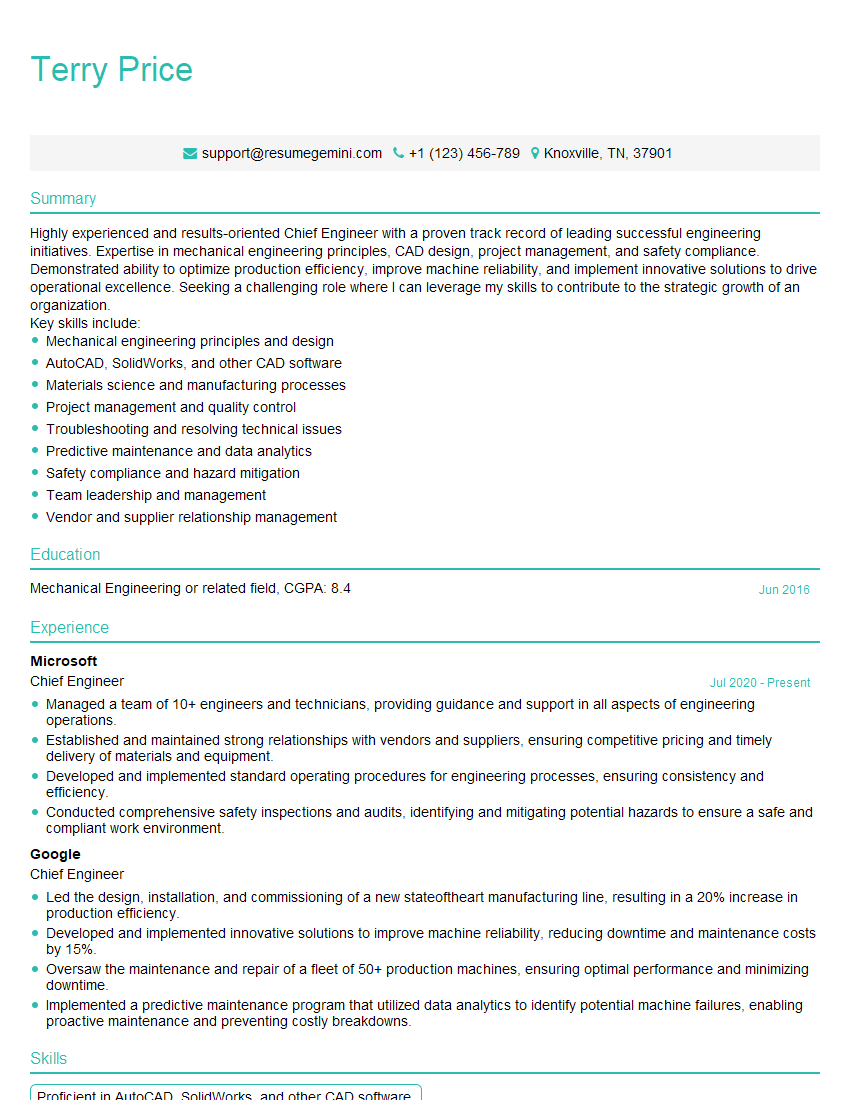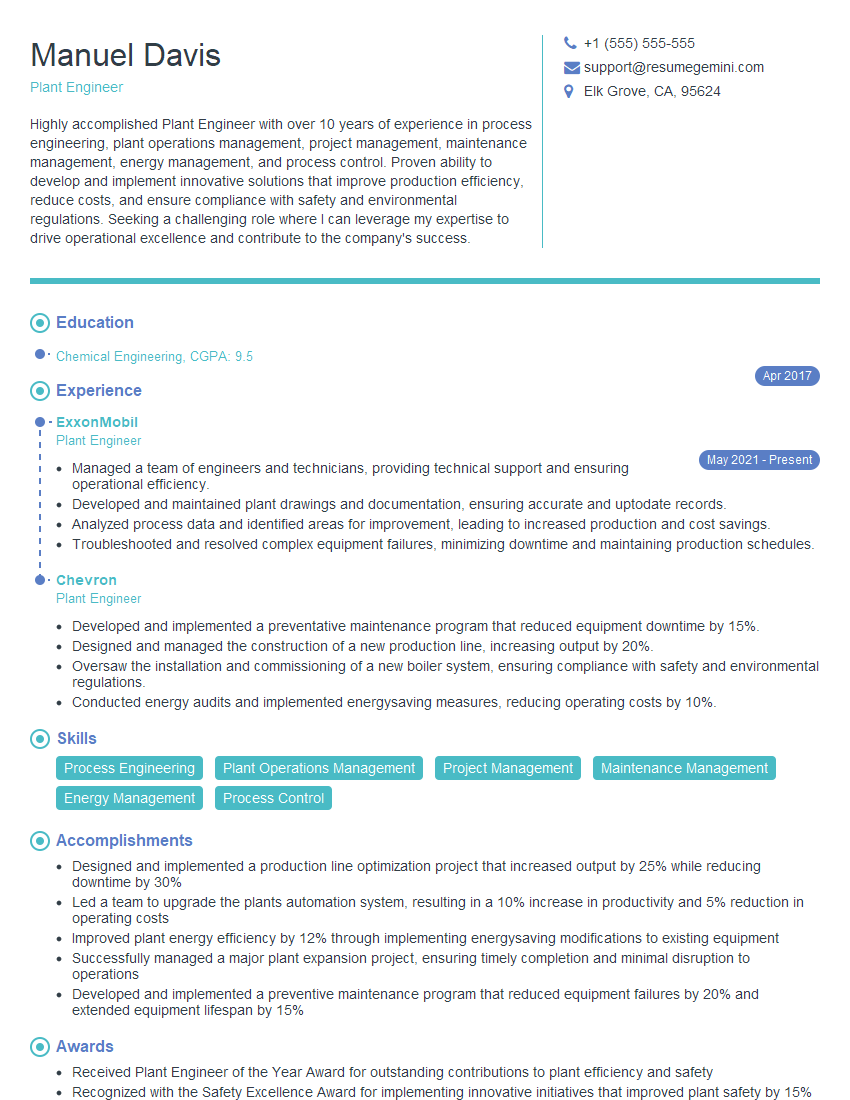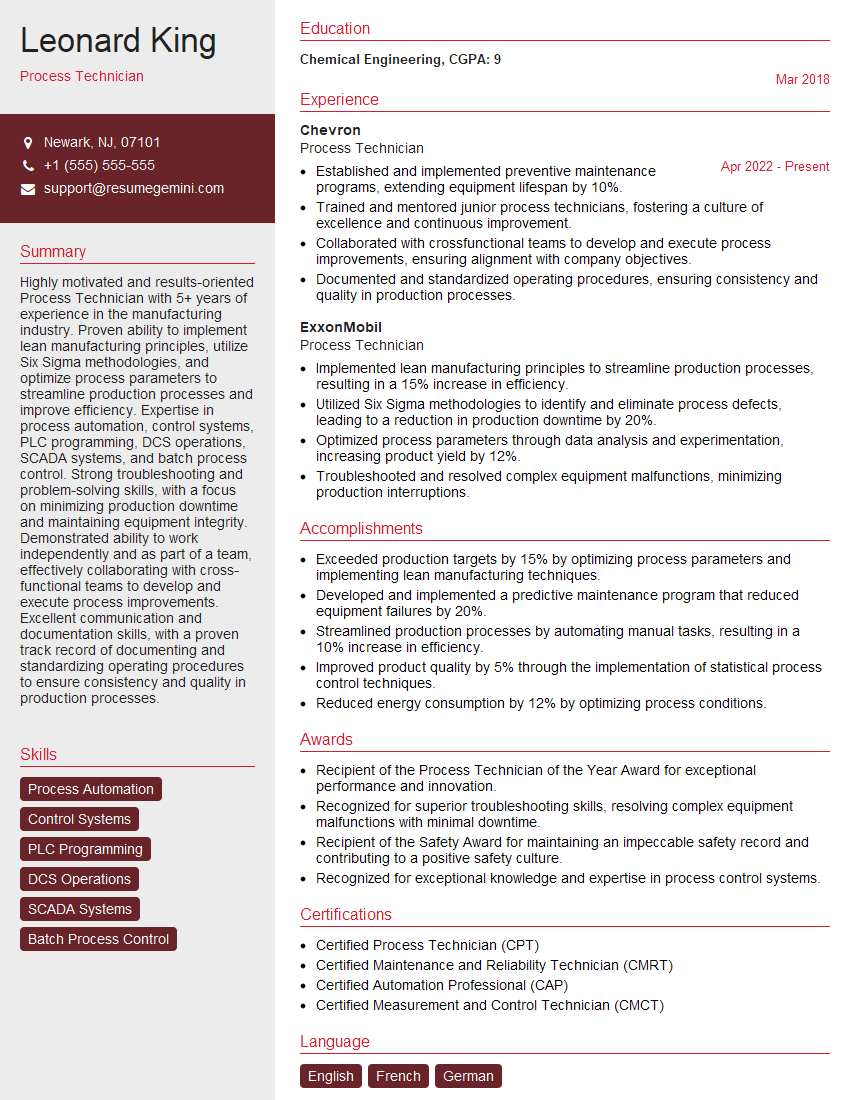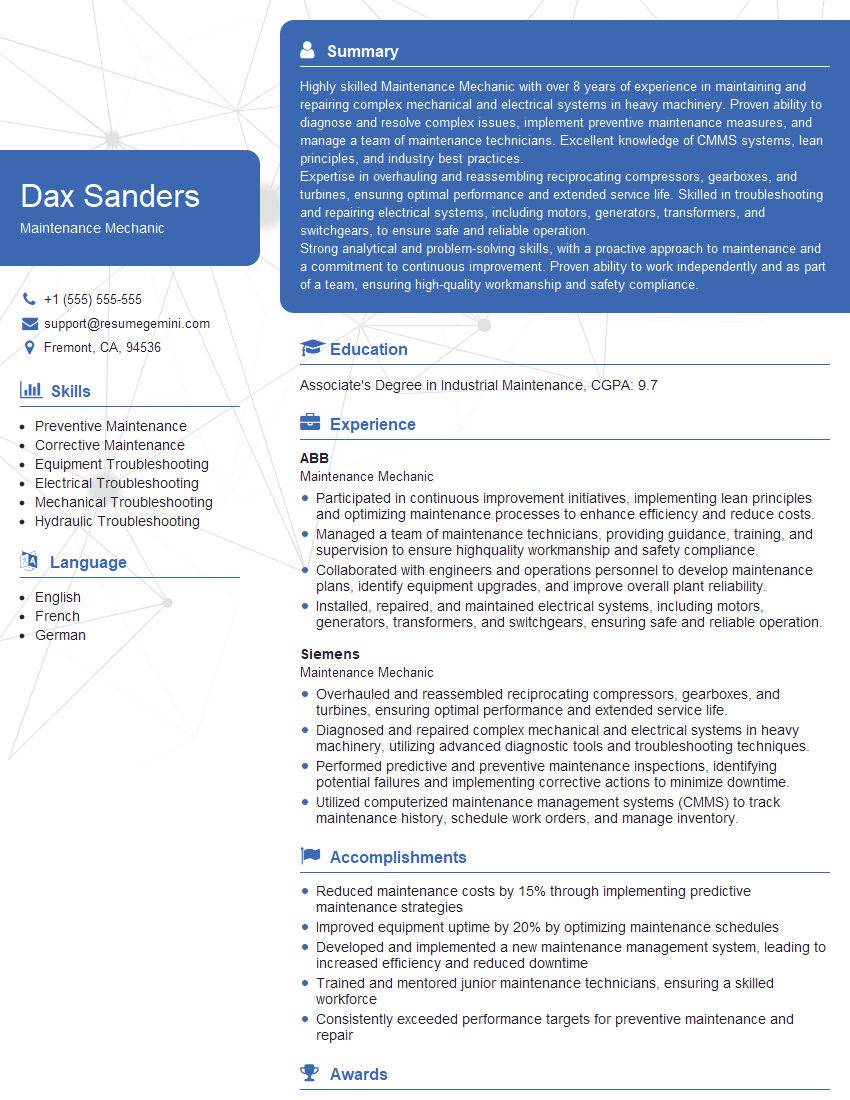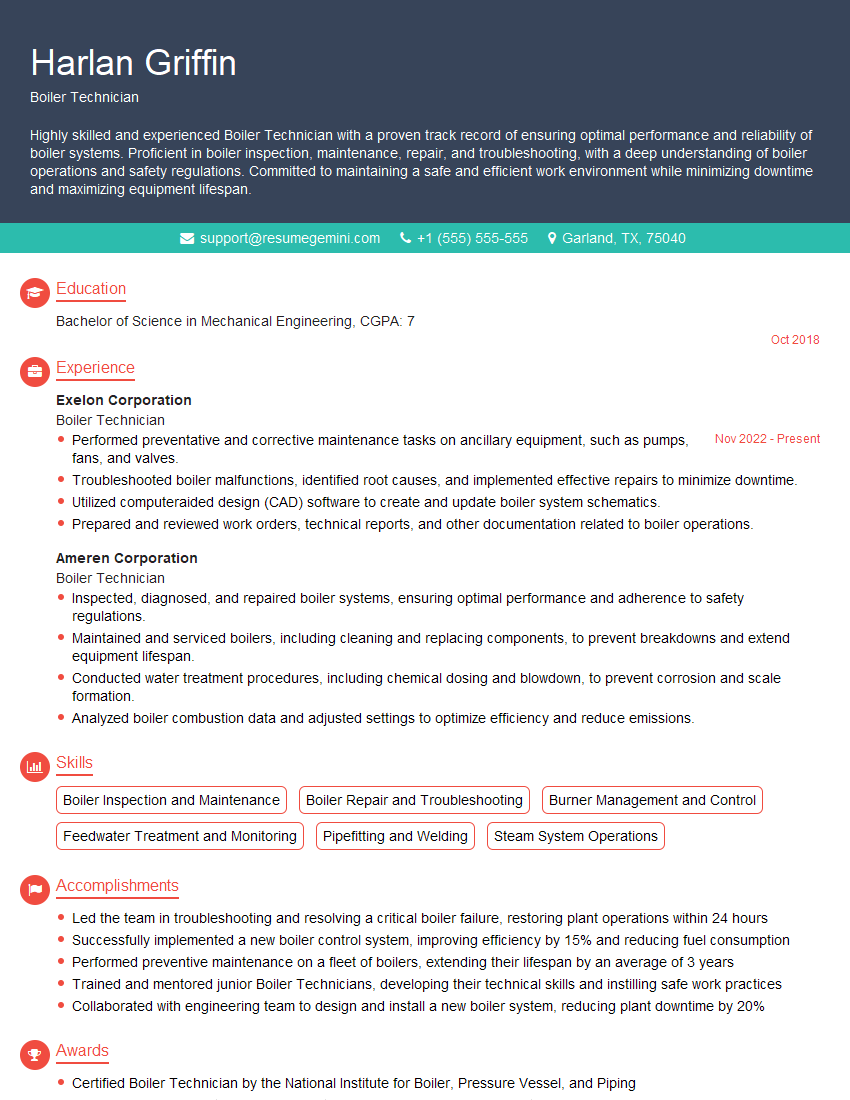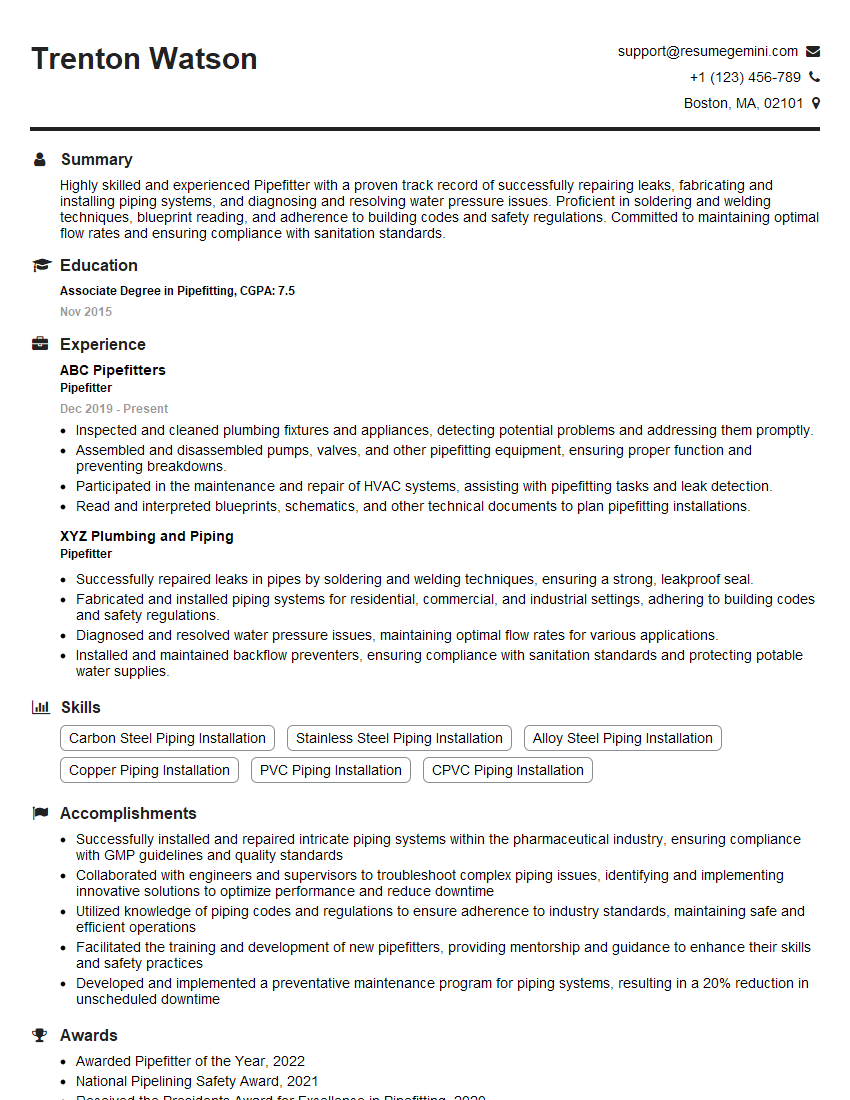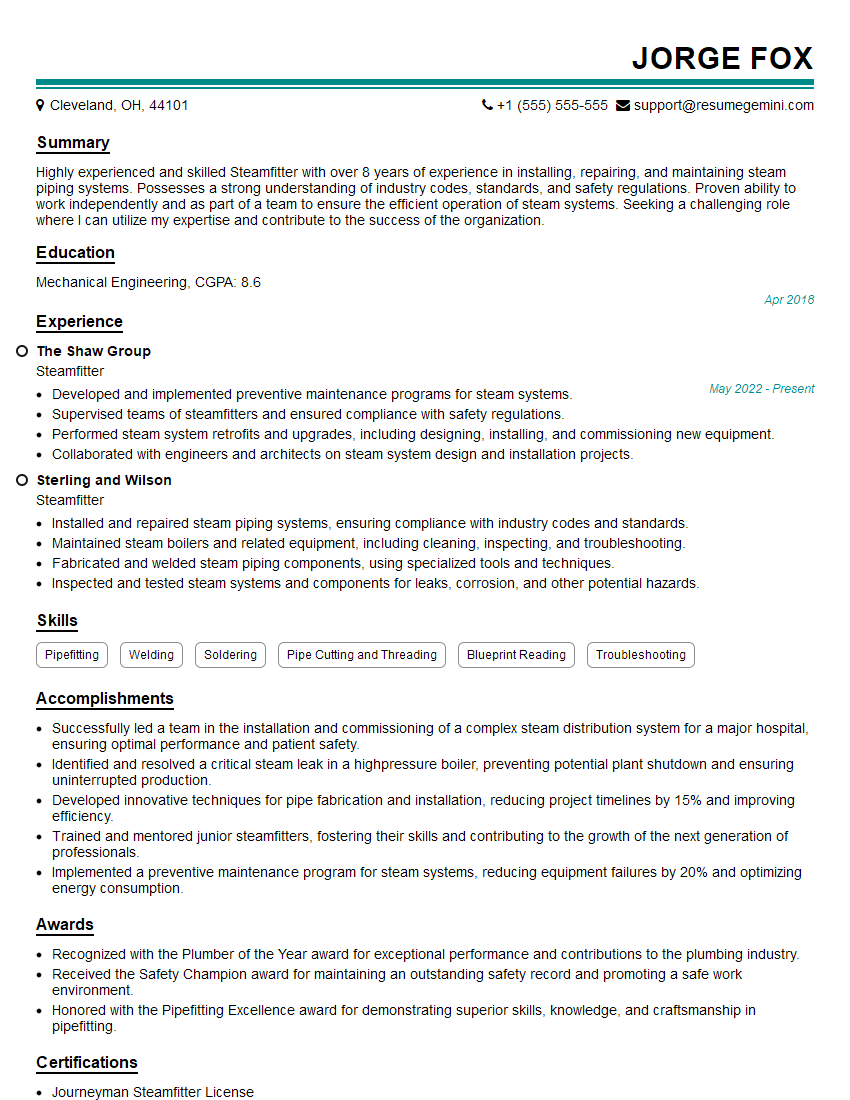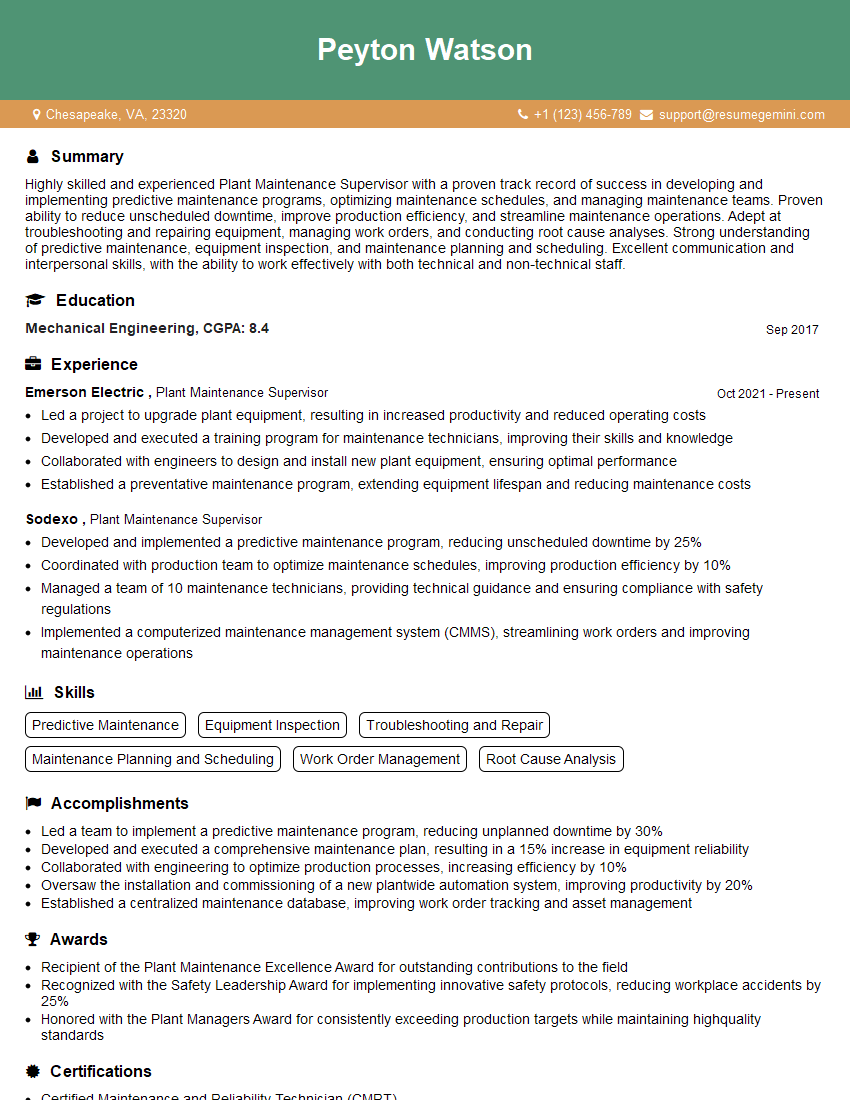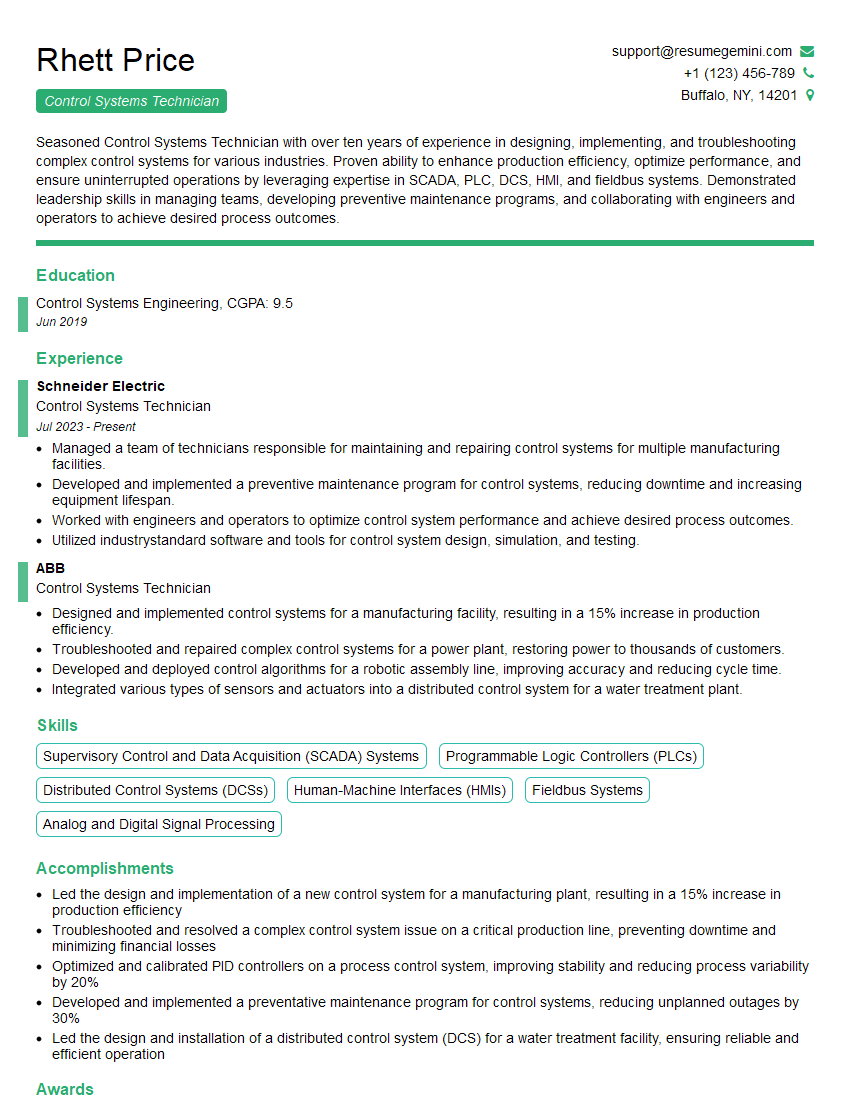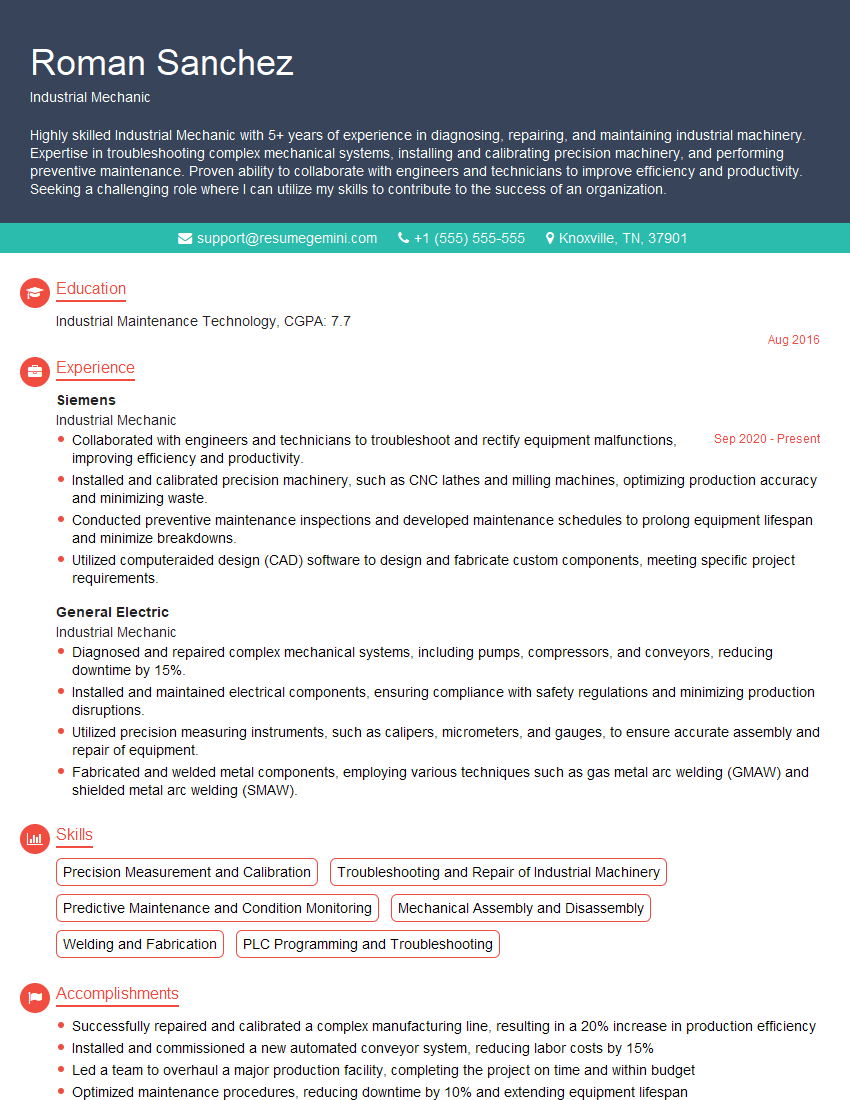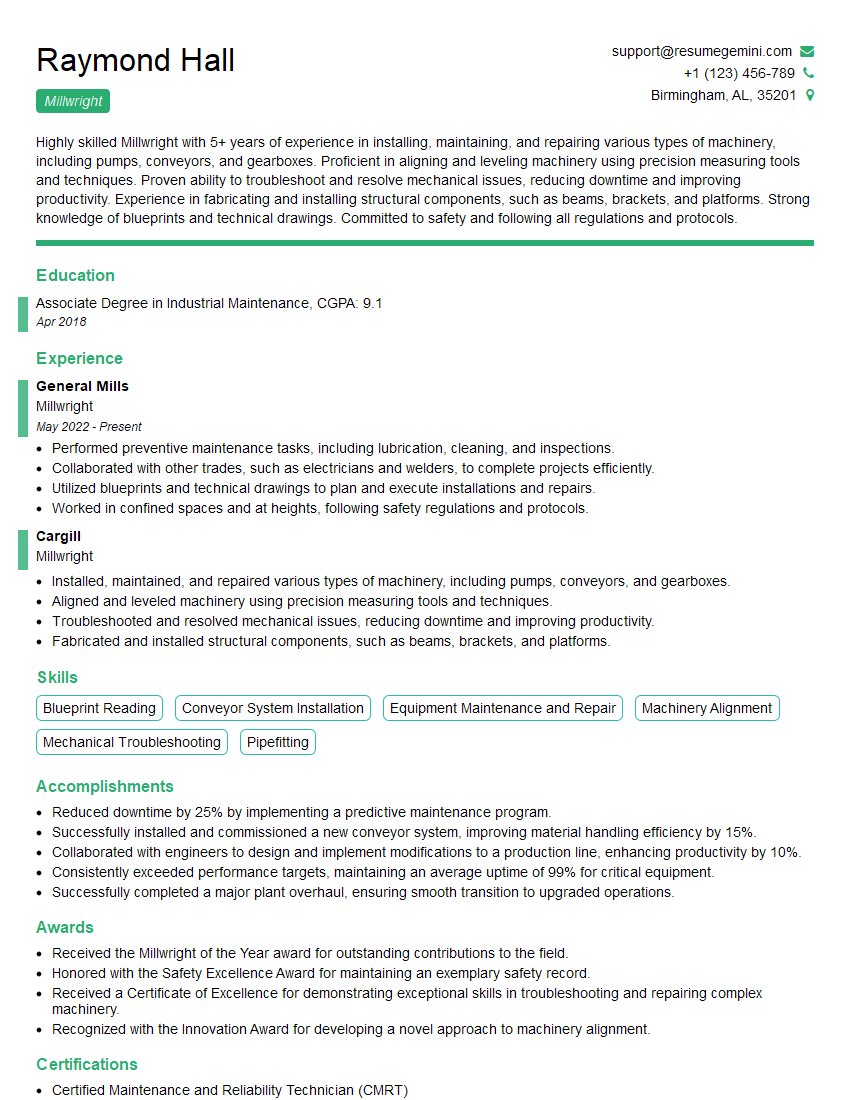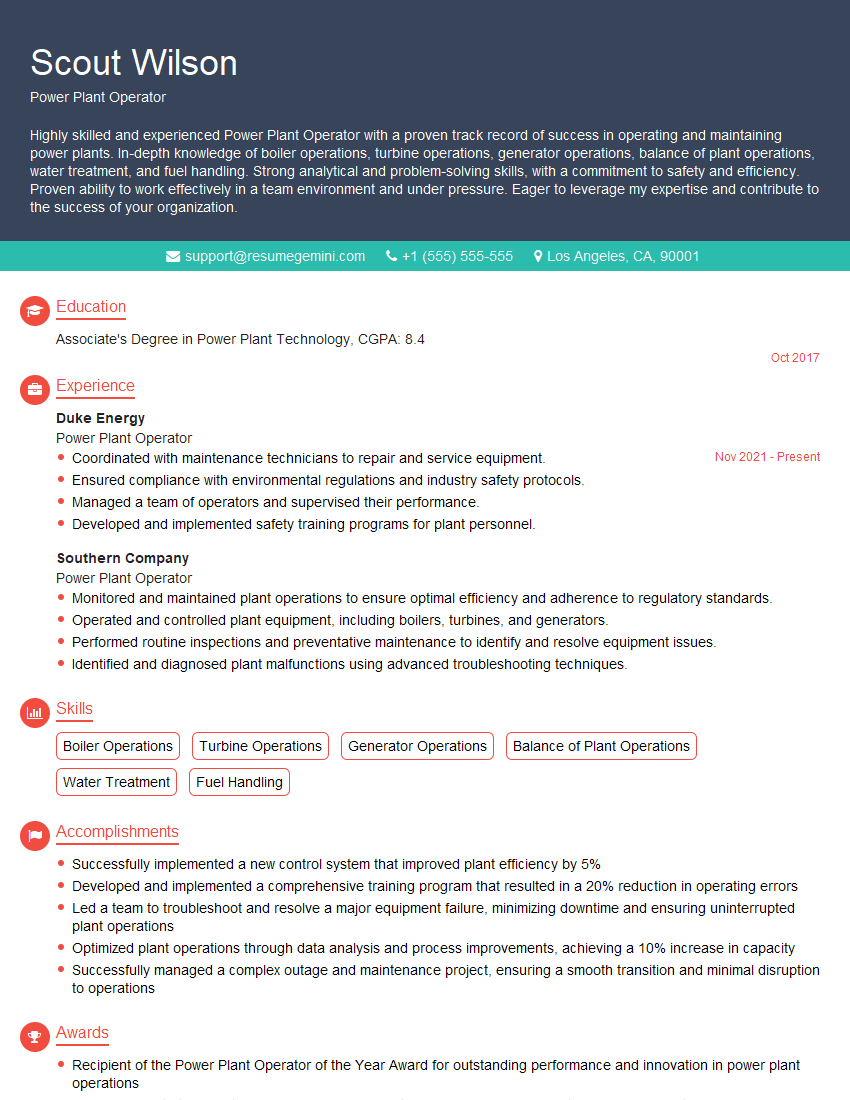The thought of an interview can be nerve-wracking, but the right preparation can make all the difference. Explore this comprehensive guide to Boiler Blowdown Valve Installation interview questions and gain the confidence you need to showcase your abilities and secure the role.
Questions Asked in Boiler Blowdown Valve Installation Interview
Q 1. Explain the purpose of a boiler blowdown valve.
Boiler blowdown valves are crucial safety and maintenance components. Their primary purpose is to periodically remove accumulated impurities, such as sludge, scale, and dissolved solids, from a boiler’s water. These impurities can reduce boiler efficiency, cause corrosion, and even lead to dangerous explosions. Think of it like regularly cleaning a coffee maker – you wouldn’t want to keep using it with old coffee grounds clogging the system. Regular blowdown prevents similar issues in a boiler.
Q 2. Describe the different types of boiler blowdown valves.
Several types of boiler blowdown valves exist, each with its advantages and disadvantages. Common types include:
- Quick-opening valves: These valves allow for rapid discharge of boiler water, ideal for frequent, smaller blowdowns. They’re simple to operate but may experience faster wear and tear with frequent use.
- Slow-opening valves: These valves provide a controlled, slower discharge, reducing the risk of thermal shock to the boiler. They’re often preferred for larger boilers or less frequent, more substantial blowdowns.
- Automatic blowdown valves: These valves automate the blowdown process, ensuring regular and consistent removal of impurities. They’re more complex but reduce manual intervention and improve consistency.
- Dual blowdown valves (surface and bottom): Many systems use both surface and bottom blowdown valves to remove impurities from different levels of the boiler water, ensuring more complete cleaning.
The choice of valve type depends on factors such as boiler size, operating pressure, blowdown frequency, and budget.
Q 3. What are the safety precautions associated with boiler blowdown valve operation?
Operating boiler blowdown valves requires strict adherence to safety procedures. Failure to do so can result in serious injury or property damage. Key safety precautions include:
- Never operate the valves when the boiler is under high pressure. Always ensure the pressure is reduced to a safe level before initiating blowdown.
- Wear appropriate personal protective equipment (PPE). This includes safety glasses, gloves, and heat-resistant clothing to protect against potential scalding or burns.
- Direct the blowdown discharge to a safe location. Ensure adequate drainage and containment to prevent scalding or environmental contamination.
- Follow the manufacturer’s operating instructions meticulously. Each valve type has specific operating procedures that must be followed.
- Regularly inspect the valves for leaks or damage. Any issues should be addressed immediately by qualified personnel.
- Properly trained personnel only should operate the valves. Unauthorized operation can lead to accidents.
Q 4. How do you select the appropriate size and type of blowdown valve for a specific boiler?
Selecting the appropriate blowdown valve involves careful consideration of several factors:
- Boiler size and capacity: Larger boilers generally require larger valves to handle the greater volume of water.
- Operating pressure and temperature: Valves must be rated to withstand the boiler’s operating conditions.
- Blowdown frequency: Frequent blowdowns might necessitate a more durable valve designed for greater wear and tear.
- Type of blowdown: Continuous or intermittent blowdown dictates valve selection.
- Material compatibility: The valve material should be compatible with the boiler water chemistry to avoid corrosion.
- Maintenance requirements: Consider the ease of maintenance and repair when choosing a valve.
Consulting boiler manufacturers’ specifications and industry standards (like ASME codes) is crucial for proper selection. An experienced engineer can help with the sizing and type selection for your specific boiler.
Q 5. What are the common causes of boiler blowdown valve failure?
Boiler blowdown valve failures stem from several causes, including:
- Corrosion: Exposure to high temperatures and chemically aggressive boiler water can cause valve components to corrode.
- Erosion: The high-velocity flow of water during blowdown can erode valve seats and other internal parts.
- Scale buildup: Mineral deposits can restrict valve operation and damage internal components.
- Improper operation: Incorrect handling or neglecting maintenance can lead to premature failure.
- Wear and tear: Frequent use and the harsh operating environment can lead to general wear and tear.
- Improper installation: Faulty installation, such as misalignment or insufficient sealing, can lead to leaks and ultimately failure.
Regular inspection, maintenance, and timely repairs are essential to prevent blowdown valve failures.
Q 6. Explain the process of installing a boiler blowdown valve.
Installing a boiler blowdown valve is a critical process that must be done by qualified personnel. Here’s a general outline:
- Preparation: Isolate the boiler section where the valve will be installed. Ensure the area is clean and accessible.
- Pipe preparation: Cut and thread the pipe to accommodate the valve. Ensure proper pipe sizing for the intended flow rate.
- Valve installation: Carefully install the valve, ensuring proper alignment with the pipe. Use appropriate thread sealant to prevent leaks.
- Connection: Connect the valve to the boiler piping using suitable fittings and gaskets.
- Testing: After installation, test for leaks under pressure. This is critical to ensure proper sealing.
- Documentation: Record the installation date, valve type, and any other relevant information.
Always consult the manufacturer’s installation instructions and relevant codes for specifics.
Q 7. How do you ensure proper alignment and sealing during installation?
Proper alignment and sealing are paramount to prevent leaks and ensure the valve’s longevity. Here’s how to achieve it:
- Accurate alignment: The valve must be aligned perfectly with the pipe to ensure a smooth flow of water and prevent stress on the valve body. Use appropriate tools like pipe wrenches and alignment tools to ensure correct orientation.
- Appropriate thread sealant: Employ a high-quality thread sealant designed for high-temperature and high-pressure applications to create a tight seal on threaded connections. Avoid over-tightening, as it can damage the valve or threads.
- Gasket selection: Use gaskets that are compatible with the valve material and operating conditions. Ensure the gasket is properly positioned and compressed to ensure an effective seal.
- Proper torque: Tighten all connections to the manufacturer’s specified torque values. This prevents leaks and ensures the structural integrity of the installation.
- Leak testing: After installation, conduct a thorough pressure test to identify and correct any leaks before commissioning the system.
Remember, a correctly installed and properly sealed blowdown valve is essential for safe and efficient boiler operation.
Q 8. What tools and equipment are required for boiler blowdown valve installation?
Installing a boiler blowdown valve requires a specialized toolkit. Think of it like performing delicate surgery on your boiler – precision is key. You wouldn’t attempt brain surgery with a rusty hammer, right? Similarly, using the wrong tools can damage the valve or the boiler itself.
- Pipe wrenches (various sizes): Essential for tightening and loosening pipe connections.
- Socket wrenches and sockets: For working with bolts and nuts on the valve body and mounting flanges.
- Pipe cutters or hacksaw: For cutting and sizing pipes to the correct length.
- Thread sealant tape (PTFE tape): Prevents leaks at threaded connections. Think of it as a waterproof bandage for your pipes.
- Level: Ensures the valve is installed horizontally for proper drainage and functionality.
- Torque wrench: Crucial for tightening connections to the manufacturer’s specified torque to avoid over-tightening and damage. This is like ensuring you don’t over-squeeze a tube of toothpaste – you want just the right amount of pressure.
- Safety glasses and gloves: Essential for protecting your eyes and hands from potential hazards.
- Welding equipment (if necessary): In some cases, welding may be required for pipe connections.
The exact tools will depend on the specific valve and boiler system, so always consult the manufacturer’s installation instructions.
Q 9. Describe the procedure for testing and commissioning a newly installed blowdown valve.
Testing and commissioning a new blowdown valve is a critical step to ensure its proper operation and prevent future problems. It’s like test-driving a new car before you hit the highway – you want to make sure everything is running smoothly.
- Visual Inspection: Check for any leaks around the valve body, connections, and piping after installation. A small leak now can become a major problem later.
- Pressure Test: Isolate the valve and gradually increase the boiler pressure to its operating pressure. Monitor for any leaks. This is like testing the car’s tires before a long journey.
- Blowdown Test: Open the blowdown valve slowly and observe the discharge. The flow should be smooth and consistent. This is like making sure the car’s brakes work properly.
- Operational Check: Verify the valve’s operation in both the open and closed positions. Ensure the valve handle operates smoothly and locks securely in both positions. This is similar to testing all of the car’s functions.
- Documentation: Record all test results and observations. This creates a record of the valve’s initial performance and is crucial for future troubleshooting.
Any abnormalities during testing must be addressed before putting the boiler into service.
Q 10. How do you troubleshoot a malfunctioning boiler blowdown valve?
Troubleshooting a malfunctioning blowdown valve requires a systematic approach. Think of it like diagnosing a car problem – you need to identify the symptoms before you can find the cause.
- Check for Leaks: Inspect the valve body, connections, and piping for any leaks. Leaks can indicate a faulty valve seal or loose connections.
- Verify Valve Operation: Ensure the valve stem moves freely and the valve opens and closes completely. A stuck valve can indicate internal damage or clogging.
- Inspect the Piping: Blockages in the blowdown piping can restrict flow and cause the valve to malfunction. This is similar to a clogged drainpipe in a house.
- Check for Pressure Drop: A significant pressure drop across the valve might indicate a partially blocked or damaged valve.
- Examine Valve Components: If possible, disassemble the valve to inspect internal components for damage or wear. This should be done by a qualified technician.
If the problem persists, consider consulting a qualified boiler technician. Attempting complex repairs without the necessary expertise can cause further damage or injury.
Q 11. What are the signs of a leaking boiler blowdown valve?
A leaking boiler blowdown valve is a serious issue that can lead to significant water loss, boiler damage, and even safety hazards. Think of it as a small hole in a dam – seemingly insignificant, but with significant consequences.
- Visible Water Leakage: The most obvious sign is water dripping or spraying from the valve body, connections, or piping.
- Water Stains: Look for water stains or discoloration around the valve indicating past or ongoing leaks.
- Steam Leakage (with high pressure): If the leak is under pressure, you might see steam instead of water, often accompanied by a hissing sound.
- Reduced Boiler Water Level: A consistently dropping water level in the boiler, even without blowdown, is a clear indicator of a leak somewhere in the system.
- Increased Water Treatment Costs: If you’re frequently topping up the boiler water, it suggests a leak. This represents a considerable financial loss.
Any sign of leakage requires immediate attention. Ignoring a leaking blowdown valve can lead to costly repairs and potential safety hazards.
Q 12. How do you perform preventive maintenance on a boiler blowdown valve?
Preventive maintenance is key to extending the lifespan of your boiler blowdown valve and preventing costly repairs. Regular maintenance is like changing the oil in your car – it ensures everything runs smoothly and prevents future problems.
- Visual Inspection: Regularly inspect the valve for leaks, corrosion, and damage. This should be part of your routine boiler checks.
- Operational Check: Periodically operate the valve to ensure smooth operation and complete opening and closing. This ensures there is no sticking or binding.
- Lubrication: Lubricate moving parts according to the manufacturer’s recommendations. This reduces friction and wear.
- Tightness Check: Check for loose connections or bolts. Tighten as needed using a torque wrench to prevent leaks.
- Clean the Valve: Remove any debris or buildup around the valve body using appropriate cleaning methods. This is especially relevant for continuous blowdown valves which can accumulate deposits.
A well-maintained blowdown valve will function reliably and require fewer repairs.
Q 13. What is the frequency of recommended maintenance for a boiler blowdown valve?
The frequency of recommended maintenance for a boiler blowdown valve depends on factors such as boiler operating pressure, water quality, and usage. However, a general guideline is as follows:
- Weekly Inspections: Visual inspection for leaks and operational checks should be performed weekly.
- Monthly Maintenance: More thorough checks, including lubrication and tightness checks, are recommended monthly.
- Annual Maintenance: A comprehensive annual inspection and servicing by a qualified technician is essential to identify potential problems before they escalate. This may involve disassembly, cleaning, and component replacement.
Remember, it’s better to be proactive than reactive when it comes to boiler maintenance. A scheduled maintenance program will save you money and headaches in the long run.
Q 14. Explain the importance of proper blowdown valve maintenance in preventing boiler damage.
Proper blowdown valve maintenance is absolutely crucial for preventing boiler damage. Neglecting this critical component can have severe consequences. Think of it as the boiler’s immune system – if you don’t maintain it, it can’t protect the boiler from harm.
- Preventing Corrosion: Proper blowdown removes impurities and dissolved solids from the boiler water, minimizing corrosion and scale buildup. This prevents internal damage and extends the boiler’s life.
- Maintaining Water Quality: Regular blowdown maintains the desired water chemistry within the boiler, preventing the formation of harmful deposits that can reduce efficiency and cause damage.
- Preventing Leaks: Regular maintenance identifies and rectifies leaks early on, preventing further damage to the boiler and avoiding costly repairs.
- Ensuring Safety: A properly functioning blowdown valve ensures that the boiler can safely and efficiently remove impurities, preventing potential safety hazards.
- Improving Efficiency: A clean boiler operates more efficiently, saving energy and reducing fuel consumption.
In short, proper blowdown valve maintenance is not just about preventing repairs – it’s about ensuring the longevity, efficiency, and safety of your entire boiler system.
Q 15. How do you handle blowdown water disposal in accordance with environmental regulations?
Blowdown water disposal must strictly adhere to environmental regulations. These regulations vary by location but generally focus on minimizing the discharge of dissolved solids, suspended solids, and potentially hazardous chemicals. We typically employ a multi-pronged approach.
Pre-treatment: Before discharge, the blowdown water often undergoes pre-treatment. This might involve cooling the water to reduce thermal pollution, using a flash tank to remove dissolved gases, and settling tanks to remove suspended solids. For boilers using chemical treatments, specific filtration or neutralization processes might be necessary to remove those chemicals before discharge.
Treatment Plants: In many cases, blowdown water is sent to a municipal wastewater treatment plant. These plants are equipped to handle the impurities and ensure safe disposal.
Recycling/Reuse: Where feasible and economically viable, we explore options for recycling or reusing the blowdown water. This could involve using it for non-potable purposes, such as cooling tower makeup water, or further treating it for other industrial applications. The key is to minimize waste.
Evaporation: In some situations, especially for smaller boilers or those in remote locations, evaporation ponds might be used. However, this requires significant land area and needs careful environmental impact assessments to prevent contamination of groundwater or surface water.
Proper Documentation: Maintaining detailed records of the blowdown water composition, treatment processes, and disposal methods is crucial for compliance and demonstrating responsible environmental stewardship.
Failure to comply with regulations can lead to hefty fines, legal action, and reputational damage. Therefore, a proactive approach, including regular monitoring and collaboration with environmental agencies, is paramount.
Career Expert Tips:
- Ace those interviews! Prepare effectively by reviewing the Top 50 Most Common Interview Questions on ResumeGemini.
- Navigate your job search with confidence! Explore a wide range of Career Tips on ResumeGemini. Learn about common challenges and recommendations to overcome them.
- Craft the perfect resume! Master the Art of Resume Writing with ResumeGemini’s guide. Showcase your unique qualifications and achievements effectively.
- Don’t miss out on holiday savings! Build your dream resume with ResumeGemini’s ATS optimized templates.
Q 16. What are the potential consequences of improper blowdown valve operation?
Improper blowdown valve operation can have serious consequences, ranging from minor inconveniences to catastrophic failures. Here are a few examples:
Boiler Water Chemistry Imbalance: Incorrect blowdown can disrupt the boiler water’s chemical balance. This leads to scaling, corrosion, or carryover (entrained water droplets entering the steam), ultimately damaging boiler components and reducing efficiency.
Equipment Damage: Sudden or excessive blowdown can cause thermal shock to the boiler tubes and other components, leading to cracks or failures. Similarly, insufficient blowdown leads to the build-up of impurities, also causing damage.
Safety Hazards: Improperly maintained or operated blowdown valves can lead to steam or hot water leaks, posing burn risks to personnel. A sudden release of high-pressure steam can also cause significant damage to surrounding equipment.
Reduced Boiler Efficiency: An inefficient blowdown system wastes energy and water, and also increases the operating cost significantly.
Environmental Violations: As mentioned earlier, improper blowdown disposal can lead to environmental violations and related penalties.
Regular inspections, proper maintenance, and operator training are crucial to prevent these issues. A well-maintained and correctly operated blowdown system is essential for safe and efficient boiler operation.
Q 17. What are the different types of blowdown systems (continuous, intermittent)?
Boiler blowdown systems are primarily categorized into two types: continuous and intermittent.
Continuous Blowdown: This system involves a constant, small flow of boiler water being continuously discharged. It’s like a slow drip, constantly removing dissolved solids and maintaining a stable concentration.
Intermittent Blowdown: This system involves periodically discharging a larger volume of boiler water at set intervals. Think of it as a quick burst of cleaning – a more concentrated effort but less frequent.
Both systems have their own advantages and disadvantages, making the choice dependent on the specific boiler application and operational requirements.
Q 18. Describe the benefits and drawbacks of each type of blowdown system.
Let’s examine the pros and cons of each blowdown system:
Continuous Blowdown:
Benefits: Maintains consistent boiler water purity, minimizes the risk of solids build-up, simpler control system.
Drawbacks: Higher water and energy waste compared to intermittent, requires constant monitoring and adjustment.
Intermittent Blowdown:
Benefits: Less water and energy waste, effective at removing higher concentrations of impurities.
Drawbacks: Requires more complex control systems, potential for higher concentration fluctuations, increased risk of localized scaling.
The optimal choice depends on factors like boiler size, operating pressure, water quality, and the overall cost-benefit analysis. Smaller boilers might benefit more from intermittent blowdown, while large industrial boilers often use continuous systems or a combination of both.
Q 19. How do you calculate the required blowdown rate for a boiler?
Calculating the required blowdown rate is crucial for efficient boiler operation. There’s no single formula, as it depends on several factors. A common method involves using the TDS (Total Dissolved Solids) concentration and the boiler’s operating parameters.
The blowdown rate is calculated to maintain the desired TDS level within the boiler. The process often involves:
Determine the acceptable TDS level: This is based on the boiler’s design, operating pressure, and the type of water treatment used. Boiler manufacturers usually provide guidelines.
Measure the incoming water’s TDS: This establishes the initial TDS concentration.
Monitor the boiler water’s TDS: Regular monitoring is crucial to track the TDS level and adjust the blowdown rate accordingly. Automated systems are often used for continuous monitoring and control.
Apply a blowdown formula: Several formulas exist to calculate blowdown based on TDS concentration. These are often specific to boiler types and manufacturers. A simplified representation (not for precise calculations) is:
Blowdown Rate (%) = (Initial TDS - Desired TDS) / Initial TDS * 100This formula offers a basic understanding; advanced calculations consider factors like blowdown frequency, boiler efficiency, and other operating conditions.
Adjust and fine-tune: Continuous monitoring and adjustment are necessary to maintain the optimal blowdown rate.
Using specialized software or consulting boiler operation manuals is strongly recommended for accurate blowdown rate calculations.
Q 20. Explain the concept of continuous blowdown vs. intermittent blowdown.
The fundamental difference lies in the frequency and volume of water removed. Imagine a bathtub:
Continuous blowdown is like leaving the drain slightly open, constantly removing a small amount of water to maintain a clean tub. It prevents significant build-up but results in a continuous water loss.
Intermittent blowdown is like periodically pulling the plug to drain a larger amount of water. It’s less frequent but removes more impurities at once.
Continuous blowdown maintains a relatively constant TDS level, while intermittent blowdown allows TDS to fluctuate more but requires less overall water usage. The choice depends on the balance between water conservation and maintaining water quality within the boiler.
Q 21. What are the factors influencing the selection of a blowdown system?
Several factors influence the selection of a blowdown system. The decision is rarely straightforward and requires a careful evaluation of several parameters.
Boiler Size and Capacity: Larger boilers often necessitate continuous blowdown to handle the larger volumes of impurities generated. Smaller boilers might be better suited for intermittent systems.
Operating Pressure and Temperature: Higher pressures and temperatures often require more frequent and controlled blowdown to prevent stress on boiler components.
Water Quality: The quality of the feedwater significantly affects the blowdown rate. Poor quality water necessitates higher blowdown to maintain acceptable TDS levels.
Cost Considerations: Continuous blowdown leads to higher water and energy waste, while intermittent systems require more sophisticated control equipment.
Environmental Regulations: The local regulations regarding blowdown water disposal directly influence the choice of system and the associated treatment processes.
Maintenance Requirements: Both systems require regular maintenance; however, continuous systems might necessitate more frequent monitoring and adjustments.
Safety Concerns: The blowdown system’s design must incorporate safety features to prevent accidents and minimize the risk to personnel.
A thorough assessment of these factors, often conducted with the help of boiler design specialists, ensures the selection of the most appropriate and efficient blowdown system for a given application.
Q 22. How do you inspect a boiler blowdown valve for wear and tear?
Inspecting a boiler blowdown valve for wear and tear is crucial for preventing catastrophic failures. Think of it like regularly checking your car’s tires – ignoring potential problems can lead to bigger issues down the line. My inspection process involves a visual check, followed by a more hands-on assessment.
Visual Inspection: I start by looking for obvious signs of damage such as corrosion, pitting, cracks, or leaks around the valve body, stem, and packing gland. I pay close attention to the valve’s surface finish – any significant discoloration or scaling could indicate internal problems. I also check for proper alignment and the absence of any damage to the connecting piping.
Hands-on Assessment: After the visual inspection, I’ll manually operate the valve, checking for smooth operation and proper seating. Any sticking, binding, or excessive play indicates potential problems. I carefully examine the packing gland for signs of leakage or damage to the packing material. If the valve is a type with a handwheel, I ensure the handwheel turns smoothly without excessive force. If it’s a pneumatic or automatic valve, I will verify its functionality through its control system.
Documentation: All findings are meticulously documented, including photographs and detailed notes. This helps track valve condition over time and informs maintenance scheduling.
Q 23. What are the different materials used in the construction of boiler blowdown valves?
The choice of materials for boiler blowdown valves is critical to ensure longevity and resistance to the harsh environment within a boiler. The materials are selected based on factors like operating pressure, temperature, and the chemical composition of the boiler water.
Body Materials: Common body materials include cast steel, forged steel, and stainless steel (various grades). Cast steel offers a good balance of strength and cost-effectiveness, while forged steel provides superior strength for high-pressure applications. Stainless steel is preferred where corrosion resistance is paramount, especially in situations with aggressive water chemistry.
Valve Trim Materials: The valve trim (internal parts that control flow) are often made from materials that can withstand erosion and corrosion. Common materials include stainless steel, Stellite (a cobalt-based alloy), and tungsten carbide. These materials ensure the valve’s operational life, despite the high-velocity steam and water flowing through them.
Gasket and Seal Materials: Proper sealing is crucial to prevent leaks. Materials like PTFE (Teflon), graphite, or other high-temperature resilient materials are commonly used for gaskets and seals.
The selection of materials is always based on a risk assessment and the specific operating conditions of the boiler.
Q 24. Explain the impact of water chemistry on boiler blowdown valve life.
Water chemistry plays a dominant role in the lifespan of a boiler blowdown valve. Think of it as the environment impacting the material. Poor water chemistry accelerates corrosion and erosion, drastically reducing the valve’s service life.
Corrosion: The presence of dissolved oxygen, chlorides, sulfates, and other corrosive agents in boiler water can cause significant corrosion of the valve’s metal components. This can lead to pitting, cracking, and eventual failure. For instance, high chloride concentration can promote pitting corrosion, weakening the valve’s structure.
Erosion: High-velocity water and steam flow during blowdown can cause erosive wear, especially at critical points like the valve seat and trim. This is exacerbated by the presence of suspended solids or abrasive particles in the boiler water.
Scaling: The deposition of mineral scales (e.g., calcium carbonate) on the valve’s internal surfaces can impede its smooth operation, cause overheating, and eventually lead to failure. Scale buildup can increase friction, making the valve difficult to open and close.
Maintaining optimal water chemistry through proper treatment and regular monitoring is crucial to extending the valve’s lifespan and ensuring safe and reliable boiler operation.
Q 25. Describe the process of replacing a faulty boiler blowdown valve.
Replacing a faulty boiler blowdown valve requires careful planning and execution to ensure safety and minimal downtime. It’s a critical process that should only be undertaken by qualified personnel.
Isolation: The first step is to completely isolate the valve from the boiler system by closing appropriate isolation valves. This prevents accidental release of high-pressure steam or water.
Pressure Relief: Ensure the pressure within the isolated section is fully relieved before proceeding. This is vital for safety.
Dismantling: Carefully disconnect the piping and remove the faulty valve. Pay attention to the orientation of the valve and any special alignment requirements.
Installation: Install the new valve, ensuring proper alignment and tightness of all connections. Use appropriate thread sealant or gaskets.
Testing: Before returning the system to operation, thoroughly inspect all connections for leaks. Operate the new valve several times to verify its proper function and check for any leaks.
Documentation: Meticulously document the entire process, including the date, time, personnel involved, and any unusual observations. This is crucial for maintenance records.
Q 26. How do you ensure compliance with relevant safety standards during installation and maintenance?
Compliance with relevant safety standards during the installation and maintenance of boiler blowdown valves is paramount. This prevents accidents and ensures the longevity of equipment. We always adhere to stringent codes and regulations such as ASME Section I and the relevant local or national codes.
Lockout/Tagout Procedures: Before any work begins, we follow strict lockout/tagout (LOTO) procedures to prevent accidental energization of the system. This is essential to protect personnel from injury.
Pressure Testing: After installation, the system undergoes pressure testing to verify the integrity of the connections and ensure there are no leaks. This is done according to the manufacturer’s guidelines and relevant safety codes.
Qualified Personnel: All work is carried out by qualified and certified personnel with extensive experience in boiler systems. This ensures adherence to safety protocols and best practices.
Regular Inspections: Regular inspections and maintenance checks are scheduled and performed to identify potential issues early on. This is crucial for preventative maintenance and safety.
Proper Documentation: Detailed records are maintained for all activities, including inspections, maintenance, and repairs. This is vital for tracking the valve’s history and ensuring compliance.
Q 27. What are some common problems encountered during boiler blowdown valve installation?
Common problems encountered during boiler blowdown valve installation can range from simple to complex. Addressing these problems effectively minimizes downtime and ensures safety.
Piping Misalignment: Improper alignment of the piping can lead to stress on the valve and its connections, resulting in leaks or premature failure.
Incorrect Valve Selection: Choosing a valve with inadequate pressure or temperature ratings for the application can lead to valve failure.
Leakage: Leaks can occur due to improper gasket installation, damaged valve components, or inadequate tightening of connections.
Difficulty in Operation: Problems with valve operation (sticking, binding) can result from inadequate lubrication, corrosion, or scale buildup.
Access Limitations: Working in confined spaces or difficult-to-reach locations can make installation and maintenance challenging.
Q 28. How do you address these problems effectively and efficiently?
Addressing these problems requires a systematic and methodical approach. We rely on both preventative measures and troubleshooting skills to minimize issues and maintain operational efficiency.
Preventative Measures: Careful planning, including proper valve selection, thorough piping design, and skilled installation techniques minimize many problems. Proper training and adherence to established procedures are essential.
Troubleshooting: When problems do occur, systematic troubleshooting is crucial. This involves careful inspection, leak testing, and thorough checks of all connections. Sometimes, the use of specialized tools (such as torque wrenches for proper tightening) is necessary.
Corrective Actions: Corrective actions range from simple adjustments (e.g., tightening connections) to more complex repairs (e.g., replacing damaged components). Each situation is evaluated individually, and the appropriate corrective actions are taken.
Documentation: All troubleshooting and corrective actions are meticulously documented. This includes the cause of the problem, the actions taken to resolve it, and the results. This documentation aids in identifying recurring problems and improving future installations and maintenance.
Key Topics to Learn for Boiler Blowdown Valve Installation Interview
- Valve Selection and Sizing: Understanding the different types of blowdown valves (e.g., ball, globe, quick-opening) and how to select the appropriate size and type based on boiler specifications and operating conditions. Consider factors like pressure, temperature, flow rate, and material compatibility.
- Installation Procedures: Mastering the step-by-step process of installing a blowdown valve, including proper piping connections, alignment, and torque specifications. Familiarize yourself with relevant safety regulations and best practices.
- Pipework and Connections: Understanding the requirements for proper pipe sizing, material selection, and connection techniques to ensure leak-free operation and system integrity. This includes understanding flange connections, welding, and threading techniques.
- Testing and Commissioning: Knowing how to thoroughly test the installed blowdown valve system for leaks, proper operation, and compliance with safety standards. This includes pressure testing and functional testing.
- Maintenance and Troubleshooting: Understanding common issues with blowdown valves, such as leaks, sticking, and erosion, and the procedures for maintenance, repair, and troubleshooting. This includes preventative maintenance schedules and common problem-solving strategies.
- Safety Regulations and Codes: Familiarity with relevant safety codes and regulations pertaining to boiler operation and maintenance, including those related to high-pressure systems and hazardous materials handling.
- Instrumentation and Control: Understanding how blowdown valves integrate with the overall boiler control system, including pressure sensors, flow meters, and automated control systems.
Next Steps
Mastering Boiler Blowdown Valve Installation opens doors to exciting career opportunities in power generation, industrial maintenance, and process engineering. A strong understanding of this critical system component demonstrates valuable practical skills and a commitment to safety. To maximize your job prospects, creating an ATS-friendly resume is essential. ResumeGemini can help you build a professional and impactful resume that highlights your skills and experience effectively. ResumeGemini provides examples of resumes tailored to Boiler Blowdown Valve Installation to give you a head start. Invest time in crafting a compelling resume – it’s your first impression on potential employers.
Explore more articles
Users Rating of Our Blogs
Share Your Experience
We value your feedback! Please rate our content and share your thoughts (optional).
What Readers Say About Our Blog
Interesting Article, I liked the depth of knowledge you’ve shared.
Helpful, thanks for sharing.
Hi, I represent a social media marketing agency and liked your blog
Hi, I represent an SEO company that specialises in getting you AI citations and higher rankings on Google. I’d like to offer you a 100% free SEO audit for your website. Would you be interested?
